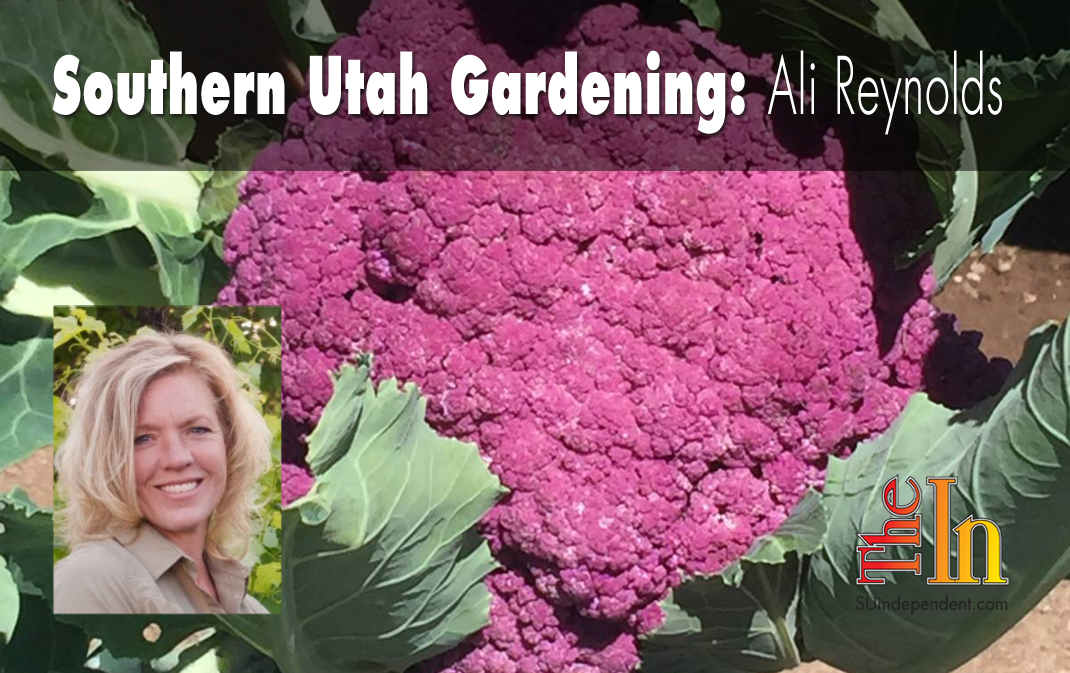
Southern Utah Gardening: Growing cauliflower
Cauliflower can be a little tricky to grow here in southern Utah, but with a few tips and tricks, you should be able to produce a nice tasty head right in your garden this spring. There are some fun colors to choose from besides the typical white, such as the green Romanesco, cheddar orange, and even purple graffiti (my husband’s favorite). Given the proper care, they all do well in our area.
Cauliflower is a cool season biennial that is grown as an annual crop. It is more sensitive to heat and drought than any of the other brassica crops (like broccoli, cabbage, or kale). So timing is critical! In warmer climates as ours, now is the best time to get transplants into the ground. Once temperatures begin to reach the mid 80’s, cauliflower will begin to button rather than form a tight head. Choose transplants (whether you grow your own or not) that are young and definitely not root-bound and with four or five true leaves. Roots should be white and loose as opposed to brown in color and tightly grown around their pot.
Cauliflower should be planted in a sunny location with well drained, fertile soil. So amend with plenty of compost before planting and in each planting hole, add 1–2 tablespoons of organic fertilizer such as a 7-7-2. If boron is not present in your soil, consider adding 1 tablespoon per 100 feet. Plant 12 to 18 inches apart. I like to plant 12 inches as this helps to keep moisture in and weeds out!
Cauliflower heads will not develop if soil is allowed to become dry, so keep soil moist but not soggy. As the plant begins to grow, you can add mulch or more compost around the plants to keep the soil moist and cool. I can’t say it enough! Cauliflower is not heat or drought tolerant!
Young seedlings are frost tolerant, but it’s a good idea to cover with a frost blanket if temperatures begin to drop below 30 degrees. Every gardener should have frost blanket on hand!
Once heads begin to form, you can tie or fold over the mature leaves to protect the heads from sun scald. This is particularly important for white cauliflower varieties.
Harvest cauliflower while the curds are still tight. Check often, every 2–3 days, because they can quickly overdevelop, turning loose and ricey. Once harvested, cool quickly to retain their quality. There’s nothing better than fresh cauliflower.
Spring-planted cauliflowers grown in warm climates do not usually send up side shoots, so I recommend removing the entire plants and offering it to the compost pile, giving space for a new warm-season crop.
Our area is perfect for sowing seeds in the late summer for a late-fall to early-winter harvest.
Some pests to watch out for early are cabbage loopers and diamondback moths. You can control these pests by using a floating row cover or doing a routine spray of Bt or spinosad. Believe me! You do not want to bite into a head of cauliflower with green worms! Planting onions, rosemary, and/or sage around cauliflower plants will also help repel pests as well as improve the flavor.




Ali,
You do your readers an injustice and put them in harm’s way when you do not state all the facts about biosolids which is little more than barely processed almost no testing industrial, medical, storm and household sewage sludge.
If you are going to promote biosolids in any way you need to state all the facts.
You should have never brought the subject up except to condemn it.
“Bio-solids are approved for use in production of agriculture;”
**US EPA 40 CFR 261.30(d) and 261.33 (4): (Every US industry connected to a sewer can discharge any amount of hazardous and acute hazardous waste into sewage treatment plants.) There are over 80,000 chemicals in commerce and growing even today. It ends up in biosolids which is broadcasted over forest, farms and even bags taken to the consumer’s home and used in their garden
**US EPA Office Inspector General (OIG) Report # 14-P-0363 in 09/2014 / Google and read it for yourself. To sum up, industrial pre-treatment is not working and has never worked and nothing has been done about it. It ends up in biosolids and sewage plant effluent. “The priority pollutants list has not been updated since 1981”
**So when you hear anyone from the multi-billion dollar sewage industry or anyone with monetary ties to any part of the sewage industry say the chemicals in biosolids are minimal and inconsequential or that they support composting with biosolids, ask them for any test showing the degree of hazard and concentrations of 80,000 chemicals that are found in biosolids or a composted biosolids like Milorganite from Milwaukee.
**Chemicals that are persistent in the environment, bio-accumulate in people and/or wildlife, and are toxic are called Persistent, bioaccumulative and toxic substances (PBTs). With more than 80,000 chemicals being injected into our environment you and your family are at considerable risk of exposure. As long as they remain in commerce and may therefore be released into the environment, they will threaten the health of humans, wildlife including aquatic life.
Cancer, Chronic Diseases and Birth Defect
http://biosludged.com/
I would never suggest that someone would use biosolids. Quit the contrary! My statement was just meant that it IS out there…Buyer beware! Many many people use it today as a cheap alternative to amend their soil. What a shame.
“Class A biosolids are approved for use in production agriculture. However, it is advisable to avoid application to vegetable gardens due to the potential for heavy metals (such as cadmium and lead). Some cities sell or give away biosolids or compost made with biosolids. It is often extremely high in salts. Use with caution.”
Like I said. Is it worth it?